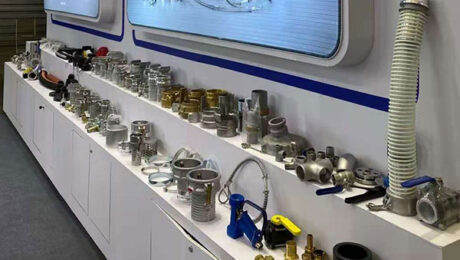Agricultural Camlock Couplings for Chemicals, Fertilizer & Irrigation
Monday, 15 December 2025
Modern agriculture relies on efficient, safe, and reliable fluid handling. K&G Machinery’s agricultural Camlock couplings are the backbone of productive farms. For corrosive liquid fertilizers and pesticides, our polypropylene and chemically-resistant EPDM or Viton® sealed couplings prevent degradation and leaks. For high-abrasion applications like slurry transfer, we offer wear-resistant nylon or urethane options for critical
- Published in Blogs
Marine-Grade Camlock Couplings for Saltwater Corrosion Resistance
Wednesday, 10 December 2025
The marine environment presents one of the most aggressive corrosion challenges. K&G Machinery’s marine-grade Camlock couplings are specifically built to endure. We utilize 316/316L stainless steel as standard, offering superior resistance to pitting and crevice corrosion caused by chlorides. For critical offshore platform applications, we offer couplings with additional protective coatings like Xylan or zinc-nickel
- Published in Blogs
Sanitary Camlock Couplings for Pharmaceutical & Bio-Processing
Tuesday, 02 December 2025
In pharmaceutical and bioprocessing, contamination is not an option. K&G Machinery’s sanitary Camlock couplings are engineered to meet the highest standards of purity and cleanability. Our couplings feature electropolished 316L stainless steel surfaces with Ra ≤ 0.8 µm, preventing bacterial adhesion and enabling effective Clean-in-Place (CIP) and Sterilize-in-Place (SIP) procedures. All wetted materials comply with
- Published in Blogs
Camlock Coupling Standards (ISO, DIN, AFNOR): What You Need to Know
Wednesday, 05 November 2025
For a system built on interoperability, nothing is more important than standards. While the cam-and-groove design is universal, several key international standards govern its precise dimensions and performance. Understanding Camlock coupling standards is essential for ensuring perfect, leak-free connections, especially in global supply chains. Why Do Camlock Standards Matter? Standards ensure that Camlock couplings from different manufacturers can connect and seal
- Published in Blogs
Common Camlock Coupling Mistakes & How to Avoid Them
Friday, 31 October 2025
Camlock couplings are famously reliable, but even the best equipment can fail if used incorrectly. These common mistakes lead to downtime, product loss, safety incidents, and unnecessary costs. Learn how to identify and avoid these pitfalls to ensure your operations run smoothly and safely. Mistake #1: Mismatching Coupling Types The Error: Trying to connect two male (Type
- Published in Blogs
How to Connect and Disconnect Camlock Couplings Safely
Thursday, 23 October 2025
Camlock couplings are designed for safety and efficiency, but only when used correctly. Improper operation can lead to sudden releases, spills, and workplace injuries. This step-by-step guide will ensure you and your team handle Camlock couplings safely every time. Before You Begin: Essential Safety Precautions Personal Protective Equipment (PPE): Always wear appropriate PPE, including safety glasses, gloves, and chemical-resistant
- Published in Blogs
How to Choose the Right Camlock Coupling: A 5-Step Buyer’s Guide
Monday, 13 October 2025
Selecting the wrong Camlock coupling can lead to leaks, chemical incompatibility, equipment failure, and serious safety hazards. This frustration is entirely avoidable. Our simple 5-step buyer’s guide will give you the confidence to choose the right Camlock coupling for your specific application, ensuring optimal performance, safety, and cost-effectiveness. Step 1: Identify the Fluid or Media The chemical composition of
- Published in Blogs
Understanding Pressure and Temperature Ratings for Camlock Couplings
Thursday, 09 October 2025
Using a Camlock coupling within its specified operating limits is non-negotiable for safety and performance. Exceeding these ratings can lead to catastrophic failure, causing leaks, equipment damage, or personal injury. This guide will explain how to interpret and apply pressure and temperature ratings for your Camlock couplings. Introduction to Camlock Ratings Every high-quality Camlock coupling is designed and tested to perform
- Published in Blogs
The Materials Guide: Stainless Steel vs. Aluminum vs. Polypropylene Camlocks
Thursday, 02 October 2025
Selecting the correct Camlock coupling type is only half the battle. Choosing the right material is equally critical for ensuring safety, longevity, and system integrity. The three most common materials are Stainless Steel, Aluminum, and Polypropylene. This guide will help you choose the best one for your application. Why Material Selection Matters The material of your Camlock coupling determines its: Chemical Compatibility: Resistance to corrosion
- Published in Blogs
Camlock Coupling Types: A Complete Guide to A, B, C, D, DP, E, F, M Adapters
Tuesday, 23 September 2025
The universal adoption of Camlock couplings is largely thanks to their standardized typing system. This system ensures that couplings from different manufacturers can interoperate seamlessly. Understanding these Camlock coupling types is the most critical step in building a safe and functional fluid transfer system. Introduction to Camlock Coupling Types Camlock types are identified by letters (A, B, C, D, E,
- Published in Blogs

